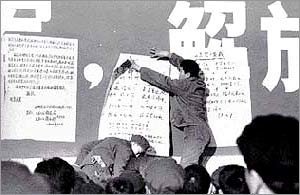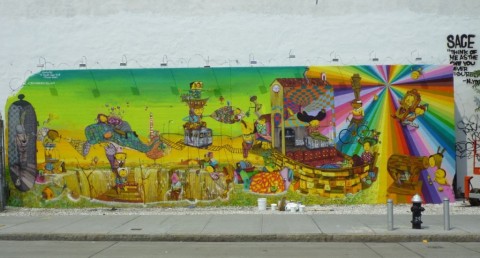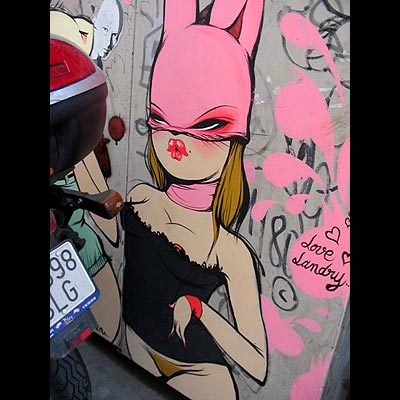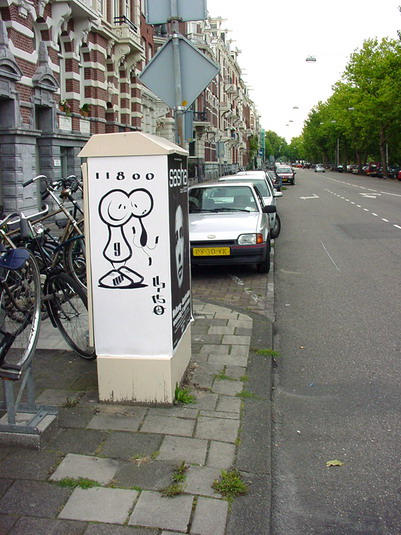The Future of Graffiti
The most important/well-known technology-based graffiti website is Graffiti Research Lab. There are some sweeeet videos there.
Electro-Graf: Uses confuctive spraypaint and magnet paint to embed LEDs (Video here)
LED Throwies (also see people tagging up Amsterdam trains with throwies!)
Night Writer: Throwie tags up high!
GIF Theater: LED screens to project moving animations
L.A.S.E.R.: Projection Graffiti (this is my personal fave! the description: “In its simplest form the Laser Tag system is a camera and laptop setup, tracking a green laser point across the face of a building and generating graphics based on the laser’s position which then get projected back onto the building with a high power projector.” And for you techy/CS people who wanna try it out, here’s the “how to and source code.”… also check out the”El Corte Inglés” video at GRL, and this projection over Machu Picchu!)
Pixel Graph: make pixel-font tags, stencils, art, etc.
PixelRoller: rollers as printers for digital image
Light Brix: touch-sensitive lights
Applied Autonomy’s “Little Brother”: robot propaganda pamphleteer (also check out “Graffitiwriter” and “Streetwriter”)
Bikes Against Bush: printing chalk messages sent from users on street during RNC
Video Game: Mark Ecko’s Getting Up: Contents Under Pressure (featuring voice of Talib Kweli, released in 2005)
And more fun indoors (your personal digital graffiti wall, fake spraycan and all)
Graffiti Creator: Make graffiti tags digitally (thanks to Reese for the link!)
…and there are plenty of non-technology based “street art” interventions, like guerilla gardening!
Or reverse graffiti (“tagging” by cleaning city grime off public spaces, see here too)
Favorite Political Graffiti Facts and Anecdotes
1. In the Republic of Ireland, where abortion and abortion counseling are illegal, women found numbers to secret hotlines scribbled in public rest room stalls.
2. In Japanese-occupied Korea (1910-1945), the country’s native tongue was banned, but wall graffiti kept the language alive and public.
3. Throughout Latin America, groups have used graffiti/posters to single out individuals to issue death threats before actually carrying them out. Targets have included academics, human rights workers, and journalists.
4. In Chile, under Salvador Allende (1970-1973), murals with slogans were thought to pique semi-illiterates’ interest in learning how to read.
5. During the Palestinian Intifada (Dec. 1987), Palestinian youth painted the national flag on building after building to symbolically mark the territory as belonging to their country.
6. In the Democracy Wall Movement (1987-1979) in China, students pasted posters listing their grievances, acts that stirred public debate. And when the student democratic movement reemerged in 1986 after a government crackdown, posters again became their medium of protest. It also allowed the movement’s leaders to propose solutions. The government tried to counteract these posters by ordering building managers to put up their own pro-government banners. And as the government began another period of extreme repression, it continued to use that form of mass communication. Most notably, the Party used posters to announce executions; a red check was then added at the bottom after they had been carried out.
7. In Romanian President Nicolae Ceauşescu’s penultimate speech, he said that Soviet-style reform would come when pears began to grow on apple trees, and student activists at the University of Bucharest hung lots of pears on the barren trees that lined the main street in the capital. Ceauşescu was so enraged by the political taunt that he ordered the Securitate (secret police) to identify the offenders. The students were all attacked in their dorms, and some were killed.
8. In 1978, a group of exiled South Africans living just across the border in Botswana formed the Medu Art Ensemble. They produced over fifty posters and then sent them into South Africa to be illegally posted. A few years later, Medu organized a conference to train South Africans to make their own silkscreened posters; over 5000 people crossed the border to attend. Immediately following the event, the South African government banned Medu posters. In 1985, South African army units went into Bostwana, killed twelve Medu members, and destroyed the homes of others. But by that point, South Africans had already set up their own domestic silkscreen workshops and studios—and despite government attempts to destroy the groups’ equipment, detain the employees, or bomb workshops, the posters only became more popular.


Alongside the poster movement was the political (scrawled) graffiti movement. Right-wing graffiti writers, who converted anti-apartheid slogans like “Free all Detainees” into “Freeze all Detainees,” had the support of the police and could therefore work in broad daylight. But even so, the anti-apartheid graffiti tended to be much more prolific. Lastly, around the same time, a political t-shirt trend emerged. Especially during funerals for important activists, thousands would show up with commemorative t-shirts. This practice became so widespread that the state began banning such t-shirts, and even arrested people for wearing them.
And in Argentina:
9. The Church knew that graffiti was the communication method of the masses. Consequently, it launched an anti-Peron street campaign in 1946, which included slogans like “Christ or Perón.” Again in 1986, when a bill that would legalize divorce was introduced, the Church stepped in, mounting another extensive campaign to stop the bill. My favorite graffiti responses? “In order to defend the family what is necessary is more housing, better salaries, more jobs, more schools, [and] more hospitals. You do not protect divorce by opposing a law but by improving the living conditions of the people.” Also: “Divorce for everyone except the Catholics.”
10. A more spectacular human rights stunt:
April 22 1985: The night before the trials of the nine ruling junta members who governed during the dirty war, an anonymous group painstakingly wrote on the famous obelisk in Buenos Aires the names of each of the 1200 individuals identified in the human rights commission’s report, Nuncas Más. Accompanying graffiti read, “All should be tried and none granted amnesty.”
**And, of course, there’s the most famous French May of 1968. In fact, the South African anti-apartheid posters often borrowed heavily from, even copied, the posters from French May. (But that political graffiti story isn’t one of my favorites.)
Some more topical reading:
Josh MacPhee (Justseeds) article about 4 different political graff interventions by French May art students, Nicaraguan Sandanistas, South African anti-apartheidists, and Argentine post-2001 economic crisis protesters.
Julie Peteet article in Cultural Anthropology on Palestinian Intifada graffiti
Lyman Chaffee’s book: Political Protest and Street Art: Popular Tools for Democratization in Hispanic Countries (available at Green library
Claudia Kozak’s book (in Spanish): Contra la pared (probably not available in the states, so ask me to borrow it if you’re interested)
Julio Cortázar’s fictional short story “Graffiti,” in the anthology We Love Glenda So Much and Other Tales (available at Green library; also handed out in classes… ask me for a copy if you missed class and are interested)
Shepard Fairey
“Repetition works…. Over time, even something that was perceived as dangerous can become familiar enough so that it becomes comfortable”
FAIR USE TRIAL: THE PHOTOS
FAIR USE TRIAL AND OPINION
Shepard Fairey admits tampering with evidence (Obey website)
Charlotte Allen’s anti-Fairey column re: fair use case (LA Times)
Christopher Knight’s response to the Allen column (LA Times)
Review by Peter Schjeldahl cited in two earlier articles (New Yorker)
Blog commentary on Fairey (the second one is especially interesting
OBEY GIANT
VIDEO INTERVIEWS
Fairey speaking about his art, in response to winning the art award by USA Today (2009)
Interview from Feb 2009, a good overview of the Hope poster and Fairey’s career:
Interview from 2006, more about his thoughts/philosophy:
the continuation is here.
Video of Fairey making a poster (the process):
Jonathan Levine Gallery interview with Fairey in his L.A. home garage studio
NEWS AND WRITTEN INTERVIEWS
Fairey arrested on way to ICA Boston exhibit (15th arrest) (Boston Globe)
Times Topics page on Fairey (NYTimes)
GALLERY SHOWS AND CORPORATE DEAL
Fairey and Levi’s team up (Hypebeast)
ICA Boston “Retrospective”--premature much? (press release)
THE SPLASHER(s)
16-page splasher manifesto (pdfs to be downloaded off NYTimes)
NYTimes article (June 28, 2007)
NYTimes article (June 30, 2007)
THE RAT RACE: Blek le Rat and Banksy
“Every time I think I’ve painted something slightly original, I find out that Blek Le Rat has done it as well. Only twenty years earlier” –Banksy
Blek le Rat
Article from The Independent, 19 April 2008
Banksy
Article from The New Yorker, 14 May 2007
Banksy’s first interview, The Guardian, 17 July 2003
Is this Banksy? The Evening Standard Photo
*Ask me to borrow either of the Blek/Banksy books. They’re both great!
Latin America
!! HOMEWORK FOR NEXT WEEK !!
1) look at Banksy and Blek le Rat websites and/or articles,
2) email me (or bring in a written blurb) your final topic proposal! If you’re gonna write a paper, just say on whom/what movement/what city/etc. If you’re gonna do a creative project, tell me what kind. (In either case, please use any/all of the links on this blog for inspiration. You can also google, flickr, or fotolog. Or email me/talk to me after class!)
3) email me (or bring in a list) of materials you would like for your in-class creative project. if there are leftover materials, you may borrow/use them for your final project (to be presented Week 10). THIS IS SUPER IMPORTANT. PLEASE DO NOT FORGET.
Now onto the more fun stuff…
Buenos Aires, Argentina
Please ask me for recommendations! My favorites are probably Grolou (French man who, until a couple months ago, lived and worked in San Telmo, Buenos Aires), Jaz (incredible fine artist working on the streets), and Cabaiostncl (formerly one half of the collective Vomito Attackk–spanish for “throw-up”). There are plenty of others to watch for, though. Check out SMNR or just ask me!
Oh, and here’s the ppt from today’s lecture on the history of graffiti/street art in BsAs.
Spotlight: Os Gemeos (Sao Paolo, Brasil)
In the above photo, notice the Sao Paolo pichação reference/influence. Here’s a photo of what “ordinary” pichação looks like:
And back to Os Gemeos…
Here’s an ArtCrimes interview with them
Also, fun fact: In Sao Paolo, beginning in the 2000s, authorities actually asked some graffiti artists to paint murals on the train! Here’s one photo:
PLEASE do more googling of the Sao Paolo scene on your own–it is so cool!
Here’s a decent video about Brazilian graff/street art, though it’s kind of long (14 mins) and the subtitles are in white, so they can be hard to read.
Here’s one more artist I like: Zezão
Europe: Spotlights
1. SPOTLIGHT: Vhils aka Alexandre Farto (Lisboa, Portugal)
Short interview with The World’s Best Ever
Another interview
Vhils’ official website
2. SPOTLIGHT: Escif (Valencia, Spain)
Short interview (unclear who actually conducted it: Unurth Street Art? Inspire Collective?)
3. SPOTLIGHT: Miss Van (Toulousse, France / Barcelona, Spain)
Interview with Swindle Magazine
Miss Van’s official website (though it’s kind of sparse right now)
4. SPOTLIGHT: Nomad (Hamburg and Berlin, Germany)
But his stuff ranges a lot. See photos at his myspace page.
5. SPOTLIGHT: London Police (London, UK)
6. SPOTLIGHT: Blu (Italy)
Done in Buenos Aires, “MUTO”:
…which inspired a BBC advertisement “rip-off”:
Evolution of men video:
Blu’s official website
Cool set of Blu photos
Video of Blu painting in Berlin (warning: moves pretty slowly, so I didn’t find it so interesting)
Some other big names in street art (these are the names I wrote on the board at the end of class):
UK: D*Face, Eine, Invader
France: JR, Zevs…. I also like C215
Barcelona: SO MANY PEOPLE, though Pez is cool
NYC: Dan Witz, Faile, Judith Supine, Michael Defeo (aka the flower guy), WK, UFO. If you liked Swoon, also check out Elbowtow and Gaia.
Australia: Lister
Brazil: Nunca, Herber Baglione…
Class #2 – Spotlight on: ESPO (Steve Powers)
[[Blogpost under construction / in process of writing]]
ESPO (“Exterior Surface Painting Outreach”)
A Love Letter For You: current public street art campaign in Philadelphia
First and Fifteenth: Espo’s homepage
Espo on Art Crimes: click on the “Mark Surface, CFO” statement — pretty funny
Espo on Deitch Projects: gallery thumbnails
NYTimes slideshow: Ireland murals
NYTimes article (5/29/08)
Village Voice article (12/14/99): Critical of ESPO’s plans for the “Doody Rudy” performative exhibit at the Brooklyn Museum; calls him an attention-seeking careerist
Broken Windows Theory
“Broken Windows” by James Q. Wilson and George L. Kelling, published in the Atlantic Monthly in March 1982
HERE ARE SOME EXCERPTS:
“First, outside observers should not assume that they know how much of the anxiety now endemic in many big-city neighborhoods stems from a fear of “real” crime and how much from a sense that the street is disorderly, a source of distasteful worrisome encounters….
“Second, at the community level, disorder and crime are usually inextricably linked, in a kind of developmental sequence. Social psychologists and police officers tend to agree that if a window in a building is broken and is left unrepaired, all the rest of the windows will soon be broken. This is as true in nice neighborhoods as in run-down ones. Window-breaking does not necessarily occur on a large scale because some areas are inhabited by determined window-breakers whereas others are populated by window-lovers; rather, one unrepaired broken window is a signal that no one cares, and so breaking more windows costs nothing….
“Untended property becomes fair game for people out for fun or plunder, and even for people who ordinarily would not dream of doing such things and who probably consider themselves law-abiding.
“We suggest that “untended” behavior also leads to the breakdown of community controls….Such an area is vulnerable to criminal invasion.
“Knowing this helps one understand the significance of such otherwise harmless displays, as subway graffiti. As Nathan Glazer has written, the proliferation of graffiti, even when not obscene, confronts the subway rider with the ‘inescapable
knowledge that the environment he must endure for an hour or more a day is uncontrolled and uncontrollable, and that anyone can invade it to do whatever damage and mischief the mind suggests.’
“The essence of the police role in maintaining order is to reinforce the informal control mechanisms of the community itself. The police cannot, without committing extraordinary resources, provide a substitute for that informal control…
“For centuries, the role of the police as watchmen was judged primarily not in terms of its compliance with appropriate procedures but rather in terms of its attaining a desired objective. The objective was order, an inherently ambiguous term but a condition that people in a given community recognized when they saw it….
“Though citizens can do a great deal, the police are plainly the key to order-maintenance. Ironically, avoiding responsibility is easier when a lot of people are standing about….On streets and in public places, where order is so important, many people are likely to be ‘around,’ a fact that reduces the chance of any one person acting as the agent of the community.
“The key is to identify neighborhoods at the tipping point — where the public order is deteriorating but not unreclaimable, where the streets are used frequently but by apprehensive people, where a window is likare not to be shattered.”
HERE ARE SOME MORE CONTEMPORARY RESPONSES:
>>Broken Windows is wrong…
Boston Globe, “The Cracks in ‘Broken Windows,'” (2/19/06). Survey of arguments/studies against the theory (Levitt – NYC, Harcourt/Ludwig -5 major cities, Sampson/Rauschenbusch – Chicago).
Washington Post, “A Crack in the Broken Windows Theory,” (1/30/05). Sampson (Harvard) and Raudenbusch (UMich) study: perception of disorder more linked to race and class than physical disarray.
>>Broken Windows is right
The Boston Globe, “Breakthrough on ‘Broken Windows'” (2/8/09). Harvard and Suffolk University studies in Lowell, Boston.
The Economist, “Can the can,” (11/20/08). Amsterdam study.
>>Debating the issue
Legal Affairs, “Is Broken Window Policing Broken?” (10/17/05), debate between Professor B.E. Harcourt (UChicago) and Assoc. Professor D.E. Thatcher (UMichigan).
Class #2 – Spotlight on: Revs
REVS: We think art should be dangerous. Everybody’s into safe art, doing safe things in their studio. We’re bringing danger back into it. It’s got to be on the edge, where it’s not allowed.
COST: We live on the edge and that’s what makes it good.
REVS: The art world is too sissyish for us. There’s no raw quality.
COST: The galleries are too quiet. You sip a little champagne.
REVS: lt’s got to be real crude. Crude.
COST: Rude and shit. Noisier.
(Source: Artforum, 1994)

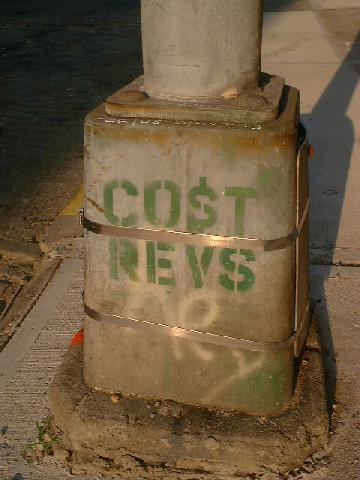





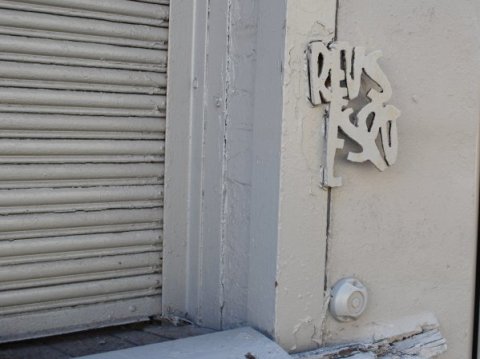

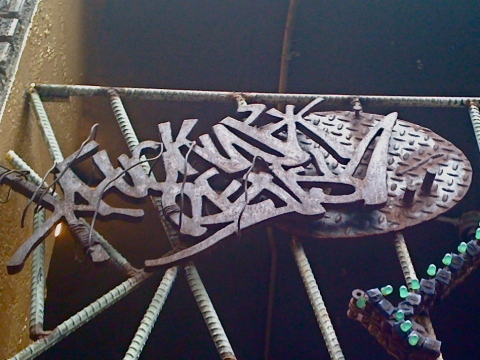

“A car can back up into it,” he said. “Somebody can get their head cracked open on it. A dog can go on it. Somebody can paint it if they want. It rusts. It’s more interesting that way, you know?”
But is it any less interesting because it’s legal?
He smiled. “I might still have a few little knickknacks scattered around in places where they’re not supposed to be, who knows?” he said. “I’m not commenting on that.”
Nytimes interview (4/18/05) –> check out the audio slideshow, link on the right panel!
 Comments (1)
Comments (1)
